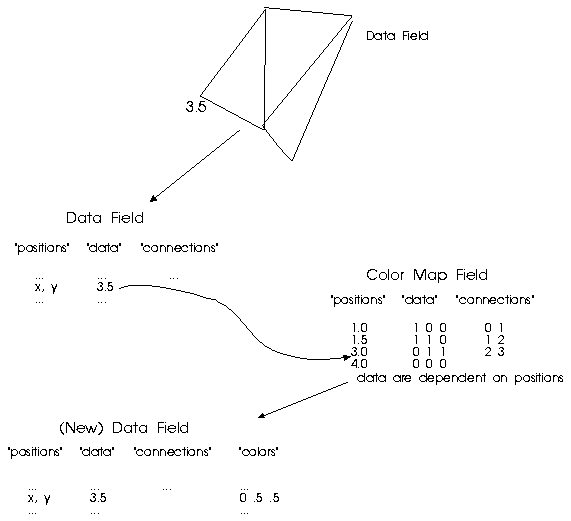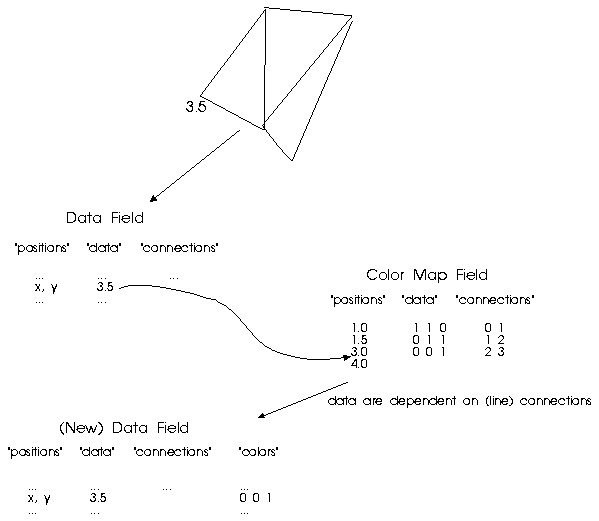input
is the field to be colored.
color
specifies how the input field is to be colored. The specification can be the vector value of an RGB color, a string, or a color map.
If color is an RGB color, the value should be in the range of 0-1 (but see "Coloring Objects for Volume Rendering"). The Convert module can convert HSV (hue, saturation, and value) colors to RGB.
If color is a string, that string should come from a lookup table, which can be specified by setting the DXCOLORS environment variable or by using the -colors flag with the dx command. If no table is specified, Data Explorer will search (in the order shown) for one of the following:
- the file colors.txt in DXROOT/lib
- the same file in /usr/lpp/dx/lib (if this was not the setting for DXROOT). Note that the colors in this file correspond to the X Window System** color list, except that the Data Explorer colors are squared first (see Appendix F. "Data Explorer Colors" in IBM Visualization Data Explorer User's Guide).
- accepts spaces in names.
- ignores capitalization.
- accepts the spellings gray and grey.
If color is a color map it can be the output of the Colormap Editor (the first output) or an imported color map. Note also that if this parameter is a color map (as opposed to a single color), then the input parameter must contain a "data" component; if the "data" component consists of vector data, the color and opacity mapping are based on the magnitude of the data. If this parameter is an imported .cm file (see Import), the color-map part of the color-opacity map is extracted and used.
Omitting the color specification allows you to change the opacity of an object without modifying its color (see reference #3 for a description of a color map).
A well-formed color map should contain a 1-dimensional "positions"
(Ref #3.)
component and a 3-dimensional "data" component.
As with any map in Data Explorer, the "positions" component represents the
domain in which to look up values, and the "data" component
represents the range, that is, the values which are associated with
items in the "positions" component.
Color maps can specify either smoothly varying colors or
constant colors across a set of ranges of data values.
If the color map has position-dependent data,
then linear interpolation
will be used to derive colors for data values in the
data field between those
given in the "positions" component of the map (see
Figure 1).
Figure 1.
Position-dependent colormaps. In this figure a diagram of a data field
is shown. One of the data values, 3.5, has been indicated. The field structure
is also shown, with "positions", "data", and "connections" components. When a
color map is applied to this field using the Color module, the data value 3.5 is
used as a lookup value into the "positions" component of the color map. The
color map has a "data" component which is dependent on (in a one-to-one
correspondence with) the "positions" component. The color map contains colors
for the value 3 (the RGB value [0 1 1], or cyan) and for the value 4
(the RGB value [0 0 0], or black). Data Explorer interpolates between
these two colors to derive the color [0 .5 .5], or dark cyan, which is
then placed in the "colors" component of the data field as the color
corresponding to the data value 3.5.

If the colormap has connection-dependent data, then the color for any data value in the data field between two values in the "positions" component of the map will be constant (see Figure 2).
Figure 2.
Connection-dependent colormaps. In this figure a diagram of a data field
is shown. One of the data values, 3.5, has been indicated. The field structure
is also shown, with "positions", "data", and "connections" components. When a
color map is applied to this field using the Color module, the data value 3.5 is
used as a lookup value into the "positions" component of the color map. The
color map has a "data" component which is dependent on (in a one-to-one
correspondence with) the "connections" component. The color map contains colors
for the range 1 to 1.5 (the RGB value [1 1 0], or yellow),
the range 1.5 to 3 (the RGB value [0 1 1], or cyan) and for
the range 3 to 4 (the RGB value [0 0 1], or blue). Since 3.5
lies in the range 3 to 4, Data Explorer looks up the color
[0 0 1] and places it in the "colors" component of the data
field as the color corresponding to the data value 3.5.

In either case, the "connections" component of the map should be a set of lines connecting the positions.
The Colormap Editor puts out a well-formed colormap. The Construct module can also be used to create a color map. For example, you have 10 data values to which you want to apply particular colors. List those 10 data values as the first parameter to Construct. Then list the 10 colors (RGB vectors) as the last parameter to Construct. This will automatically create a position-dependent color map of the appropriate structure to use with the Color module. Alternatively, if you list only 9 colors (RGB vectors) as the last parameter to Construct, a connection-dependent color map will be created.
For surfaces, RGB colors in a color map should range between 0 and 1. Compute can be used to convert colors from the range of 0 to 255 to the range 0 to 1. To choose appropriate colors for volumes see "Coloring Objects for Volume Rendering". Note that if you have an HSV (hue, saturation, and value) color map, it can be converted to an RGB (red, blue, green) color map using the Convert module.
opacity
can be a scalar value or a field specifying an opacity map. This map may be the output of the Colormap Editor (the second output) or an imported opacity map. If it is an imported .cm file (see Import), the opacity part of the color-opacity map will be extracted and used (see below for a description of an opacity map).
The input color or opacity can also be groups of color or of opacity maps, as long as the hierarchy of the group matches that of input.
For surfaces, the default value of opacity is 1.0; the valid range is 0-1. For volumes, the default value is 0.5. If the object to be colored is a volume with an aspect ratio much different from 1, it may appear dark from certain viewing directions. In that case, use the Compute module to multiply the contents of the data component of the opacity and color maps by a scale factor greater than 1 before using them as an input to the Color module. (If you are using delayed colors, modify the "color multiplier" and "opacity multiplier" attributes. See the delayed parameter, described below.)
A well-formed opacity map should contain a 1-dimensional "positions" component and a 1-dimensional "data" component representing opacities. For surfaces, valid opacities range between 0 (transparent) and 1 (opaque). To choose appropriate opacities for volumes see "Coloring Objects for Volume Rendering". Just as with a color map, the "data" component may be either position-dependent or connection-dependent. An opacity map can be created either with the Colormap Editor or using the Construct module as described for color maps.
component
specifies the component to which the module adds colors. The default is the "colors" component, which applies to both the front and the back of the object, but you can specify "front colors" or "back colors" instead. Either one, if present, takes precedence over the "colors" component. If you specify component as "colors," the module deletes any existing "front colors" or "back colors" components. Which faces are "front" and which faces are "back" depends on how "connections" component of the faces is defined (see "Standard Components" in IBM Visualization Data Explorer User's Guide).
delayed
causes Color to create "delayed colors." This option is valid only for byte data. When delayed = 1:
- the "colors" component is a copy of the "data" component, and a "color map" component is created (i.e., a color lookup table with 256 entries representing the appropriate color for each of the 256 possible data values).
- (if opacity has been specified) the "opacities" component is a copy of the "data" component, and an opacity map with 256 entries is created.
- the module adds a "direct color map" attribute to the output object (see "Using Direct Color Maps").